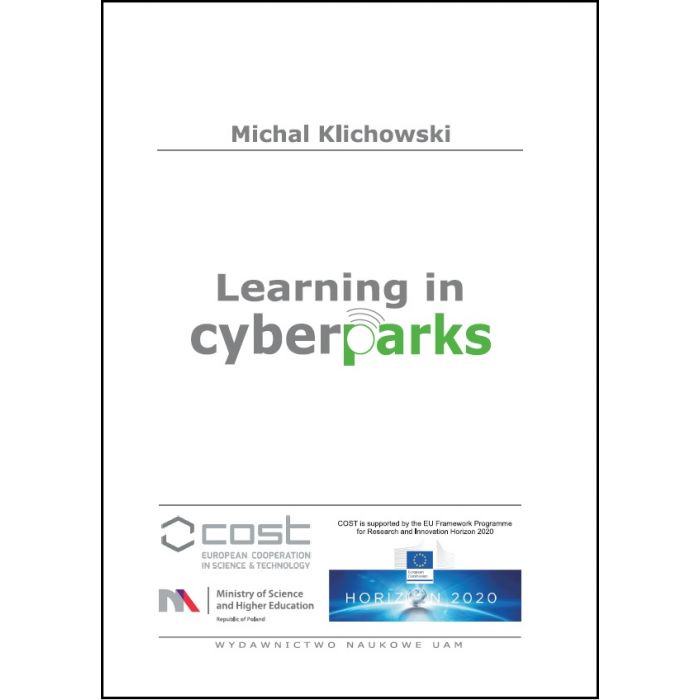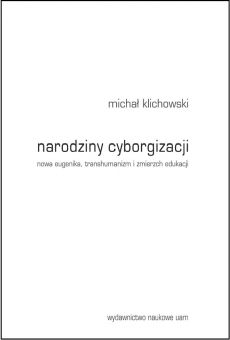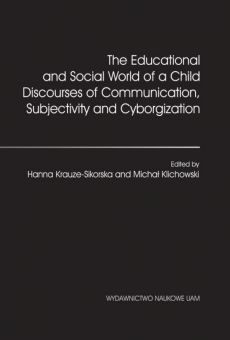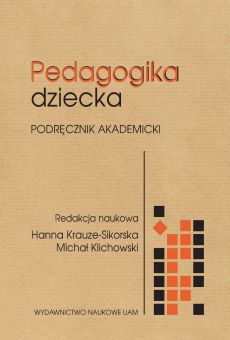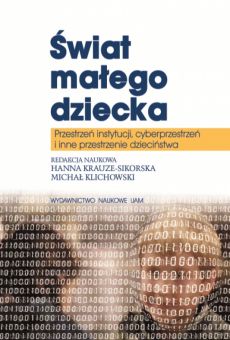Learning in CyberParks. A theoretical and empirical study
- In Stock: out of stock
- ISBN: 978-83-232-3255-1
- Category: Interdisciplinary Studies , Psychology and Education, E-books, Open Access
- Year of publication: 2017

WYRÓŻNIENIE w Konkursie o Nagrodę Stowarzyszenia Wydawców Szkół Wyższych im. Ks. Edwarda Pudełki, 22. Poznańskie Targi Książki Naukowej i Popularnonaukowej
NAGRODA NAUKOWA Wydziału I Nauk Humanistycznych i Społecznych PAN za wybitne osiągnięcie w dziedzinie pedagogiki, 2018
The theoretical part of the book shows that learning in CyberParks takes the form of technology-enhanced outdoor learning and is an element of smart learning, i.e. the latest concept of ICT-supported learning. Learning in CyberParks can also become an element of smart education – a concept of formal learning in the smart city. Learning in CyberParks is supposed to provide students with contact with nature and stimulate them to be physically active. It is thus a type of a dual task. Studies in cognitive neuroscience suggest that this type of cognitive-motor interference can expose students to a motor danger and weaken their cognitive capabilities. If this was the case, the idea of learning in CyberParks would need to be modified. In order to solve this, two experiments with the use of mobile EEG were carried out. The empirical part of the book indeed shows that during dual tasks in CyberParks students are less focused and more stressed, and the dynamics of attention and meditation ceases to reflect the dynamics of the cognitive task. Thus, before CyberParks become learning spaces, the idea of CyberParks has to be modified. The cognitive activity intended in CyberParks should be separated from physical activity. When learning in CyberParks, one should be sitting and using applications that do not require movement. Staying close to nature improves the functioning of the brain, therefore such learning is more effective than that carried out indoors. It is also more healthy. When designing CyberParks, one thus has to think not only about the technological infrastructure, but also about making spots for using ICT while sitting available. In this approach, learning in CyberParks becomes an important concept that can be used in practice in order to provide an answer to numerous problems of contemporary educational institutions, related to students’ lack of contact with nature and consolidation of their sedentary lifestyle.
The study was supported by European Cooperation in Science and Technology (COST) Action: Fostering knowledge about the relationship between Information and Communication Technologies and Public Spaces supported by strategies to improve their use and attractiveness (CYBERPARKS) (TUD COST Action TU1306). COST is supported by the EU Framework Programme for Research and Innovation Horizon 2020. The equipment used was purchased from scholarship for young outstanding scientists funded by the Ministry of Science and Higher Education in Poland (0049/E-336/STYP/11/2016). The author declares that the research was conducted in the absence of any commercial or financial relationships that could be construed as a potential conflict of interest.
Read more about the project: http://cyberparks.amu.edu.pl
Pod koniec 2013 roku zostałem powołany przez Minister Nauki i Szkolnictwa Wyższego do pełnienia funkcji reprezentanta Polski i członka zarządu czteroletniego grantu European Cooperation in Science and Technology (TUD COST Action TU1306). Konsorcjum to, zrzeszające ponad 80 naukowców z 29 różnych krajów, miało zająć się interdyscyplinarnymi badaniami nad problemem CyberParków (CyberParks). W tamtym okresie pojęcie „CyberPark” było naukowo nieopracowane, a kierunki studiów nad tym problemem nieokreślone. Okazało się także, że nikt na świecie problemem uczenia się w CyberParkach (learning in CyberParks) dotychczas się nie zajmował. Postanowiłem więc go zbadać, a książka ta jest finalnym rezultatem tych studiów. Jej podstawowym celem – wyjaśnionym we wstępie – była interdyscyplinarna, teoretyczno-empiryczna (wykorzystująca paradygmaty badawcze neuronauki poznawczej) analiza koncepcji uczenia się w CyberParkach.
Pobyty w różnych zagranicznych ośrodkach naukowych, w tym staż podoktorski w Interdisciplinary Research Centre for Education and Development (Portugalia), oraz dyskusje z naukowcami z całej Europy, pozwoliły mi dostrzec, iż ideę uczenia się w CyberParkach należy osadzić na założeniach większej (i bardzo „świeżej”) koncepcji nazywanej smart learning (inteligentne uczenie się). Ponadto, gdy uczenie się w CyberParkach ma przyjmować wymiar formalny, wtedy postrzegać należy je jako element smart education, czyli formalnej edukacji realizowanej w smart city (inteligentnych miastach). W toku dalszych poszukiwań udało mi się określić, iż od strony teorii uczenia się, uczenie się w CyberParkach jest częścią technology-enhanced outdoor learning (wspomaganego technologicznie uczenia się „na zewnątrz”). Idea uczenia się w CyberParkach sytuuje się zatem na styku dwóch olbrzymich teorii dydaktycznych: technology-enhanced learning (uczenia się wspomaganego technologicznie) i outdoor learning (uczenia się „na zewnątrz”), które w ostatnich latach pierwszy raz w historii zaczynają być łączone.
Tym samym, w pierwszej, teoretycznej części tej książki, rozważania toczą się wokół powyższych, konstytutywnych dla idei uczenia się w CyberParkach, koncepcji. Teoretyczne analizy doprowadziły jednak do zaskakującego odkrycia: jedna z najnowszych koncepcji neuronauki (the dual-task cost concpet – koncepcja kosztów podwójnego zadania) sugeruje, że uczenie się tego typu może być nie tylko nieefektywne, ale też w pewien sposób niebezpieczne dla uczniów. By kwestię tę wyjaśnić, przeprowadziłem dwa, realizowane w paradygmatach neuronauki poznawczej, eksperymenty, których założenia i wyniki zostały przedstawione w drugiej (empirycznej) części książki.
Książka kończy się dyskusją, ukierunkowaną na interpretację uzyskanych wyników, ale także na przełożenia ich na praktykę. Sugeruje ona pewne przeformułowanie założeń CyberParków, dzięki któremu przestrzenie te będą mogły stać się nie tylko przestrzeniami innowacyjnego uczenia się, ale także elementem formalnej edukacji.
Więcej o projekcie: http://cyberparks.amu.edu.pl
Foreword (Carlos Smaniotto Costa)
Acknowledgments
General introduction and background
PART I
Learning in CyberParks – a theoretical study
Chapter 1: Technology-enhanced learning
Introduction
1.1. Technology-enhanced learning concept
1.2. The history of technology-enhanced learning
1.2.1. E-learning
1.2.2. M-learning
1.2.3. U-learning
1.2.4. Smart learning – towards smart education
1.3. Technology-enhanced learning from the perspective of recent studies
1.3.1. Selected recent studies and a positive influence of technology-enhanced learning
1.3.2. Selected recent studies and a negative influence of technology-enhanced learning
1.3.3. Selected recent studies and the need to personalize technology-enhanced learning
1.3.4. The need for research in cognitive neuroscience and psychophysiology
Conclusions
Chapter 2: Outdoor learning
Introduction
2.1. Outdoor education
2.2. Outdoor learning concept
2.3. Outdoor learning from the perspective of recent studies
2.3.1. Selected recent studies and the benefits of outdoor learning
2.3.2. Selected recent studies and barriers of outdoor learning
Conclusions
Chapter 3: Technology-enhanced outdoor learning
Introduction
3.1. Smart city concept
3.2. Smart education – towards learning in CyberParks
3.3. The CyberParks concept
3.3.1. Learning in CyberParks
3.3.2. Learning in CyberParks from the perspective of recent studies
3.3.3. Learning in CyberParks and the dual-task cost
Conclusions
PART II
Learning in CyberParks – an empirical study
Chapter 4: Learning in CyberParks and the dual-task cost: experiment under natural conditions
4.1. Methods
4.1.1. Participants
4.1.2. Procedure and equipment
4.1.3. Data analyses
4.2. Results
4.2.1. Sternberg tasks
4.2.2. Two-back tasks
Chapter 5: Learning in CyberParks and the dual-task cost: laboratory experiment
5.1. Methods
5.1.1. Participants
5.1.2. Procedure and equipment
5.1.3. Data analyses
5.2. Results
5.2.1. Sternberg tasks
5.2.2. Two-back tasks
Chapter 6: Supplemental analyses comparing outdoor and indoor learning
6.1. Data analyses
6.2. Sternberg tasks
6.3. Two-back tasks
Discussion and conclusions: how to learn in CyberParks?
List of figures and tables
Appendix A. Memorandum of Understanding for the implementation of a European Concerted Research Action designated as COST Action TU1306: Fostering knowledge about the relationship between Information and Communication Technologies and Public Spaces supported by strategies to improve their use and attractiveness (CYBERPARKS)
Appendix B. Stimuli used in experiments
Appendix C. Combinations of stimuli
References
| Detailed information | |
|---|---|
| Publication Version | e-book |
| Format | 17,0 x 24,0 |
| Language | angielski |
| Type of publication | Monografia |
| Edition | I |
| Series | Badania Interdyscyplinarne nr 49 |
| ISSN | 1895-376X |
| ISBN | 978-83-232-3255-1 |
| Number of pages | 268 |
| Number of publishing sheets | 15,00 |
